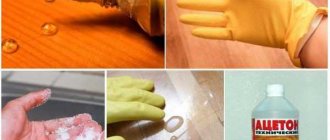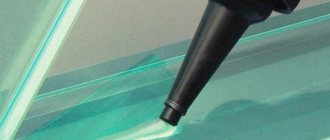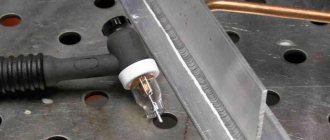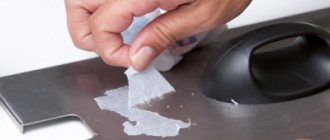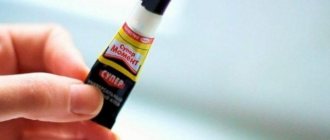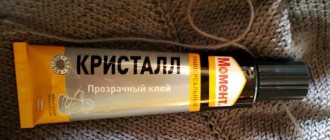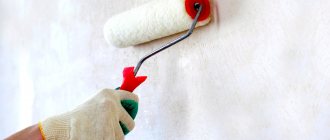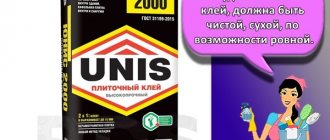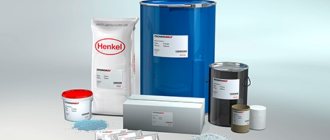Do you want to affordably update your interior? One of the easiest ways is to transform the surface of the furniture.
First you need to remove the previous coating. After removing the film, glue remains. Sometimes it is very difficult to wipe it off, it sticks so tightly to the coating. Contaminants must be completely removed so as not to spoil the appearance of the furniture.
How to properly remove glue from self-adhesive film from furniture - we will look at this article.
There are effective simple and complex ways to do this at home. First you need to decide - what products will be safe to cover your furniture?
It would be nice to know what kind of adhesive base this is? How long has it been since pasting?
If you want to preserve the integrity of the furniture as much as possible, start from an inconspicuous place.
Sometimes you have to try several options before you get the desired result.
First, try wiping off the glue with hot water and a soft cloth to avoid scratching the coating. If it is water-based, it will clean well. Then, if necessary, use other, more labor-intensive methods.
How to remove glue from self-adhesive film from furniture at home
Do you want to affordably update your interior? One of the easiest ways is to transform the surface of the furniture.
p, blockquote 1,0,0,0,0 —>
First you need to remove the previous coating. After removing the film, glue remains. Sometimes it is very difficult to wipe it off, it sticks so tightly to the coating. Contaminants must be completely removed so as not to spoil the appearance of the furniture.
p, blockquote 2,0,0,0,0 —>
How to properly remove glue from self-adhesive film from furniture - we will look at this article.
p, blockquote 3,0,0,0,0 —>
p, blockquote 4,0,0,0,0 —>
There are effective simple and complex ways to do this at home. First you need to decide - what products will be safe to cover your furniture?
p, blockquote 5,0,0,0,0 —>
It would be nice to know what kind of adhesive base this is? How long has it been since pasting?
p, blockquote 6,0,0,0,0 —>
If you want to preserve the integrity of the furniture as much as possible, start from an inconspicuous place.
Sometimes you have to try several options before you get the desired result.
p, blockquote 8,0,0,0,0 —>
First, try wiping off the glue with hot water and a soft cloth to avoid scratching the coating. If it is water-based, it will clean well. Then, if necessary, use other, more labor-intensive methods.
p, blockquote 9,0,0,0,0 —>
p, blockquote 10,0,0,0,0 —>
How to clean metal
Metal surfaces are resistant to high temperatures, chemicals, and abrasives. The latter is only provided that the base is not polished. This makes the task much easier than removing #glue from a sticker from metal. To remove sticky residues, use any suitable object: knife, spatula, etc. It is advisable to first dissolve or soften the glue. To do this, take solvent, gasoline, oil, soapy water.
Preheating gives good results. Moreover, the metal will withstand even high temperatures, so you can use a hair dryer. True, it is better to set it to low power. Some difficulties arise when cleaning a refrigerator with a stainless steel coating. It does not tolerate abrasives and can be damaged by inappropriate chemicals. It is optimal to use heat here.
Pixabay
Special formulations
There are specially designed products on sale for cleaning contaminants from any place. Suitable for you:
p, blockquote 11,0,0,0,0 —>
- means for removing stickers and labels, traces of glue. Such aerosols are sold, for example, in a car dealership. Cleans and leaves no residue. You just need to spray the product under the edge of the film. Then slowly peel off as the composition penetrates under it. Or you can simply remove sticky marks after removing the film. Although such products are not budget-friendly, they are highly penetrating and multifunctional. Take a closer look at the “Label off” spray, the Korean tape cleaner “Kangaroo”, the glue remover “Mellerud” (suitable for wood), etc. Be sure to read the instructions;
p, blockquote 12,0,0,0,0 —>
- VD-40 is a long-known and proven drug that helps remove many stains, including glue;
p, blockquote 13,0,1,0,0 —>
- special solvents for glue will effectively help clean the surface, but you need to check how safe they are for the coating;
- COSMOFEN type cleaners are suitable for resistant materials. Good for removing glue residue from plastic. Recommended for use with special lint-free wipes;
p, blockquote 14,0,0,0,0 —>
- bitumen remover is a kerosene-based mixture. Purchased at a car dealership. You need to spray the surface with glue. Wait 2-5 minutes and easily remove with paper towels. Then wipe with degreaser. An effective method, but whether it is suitable for any furniture is a question;
- professional gels for car washes . Designed for washing cars, but efficiently and delicately helping to clean the surface of furniture from vinyl film.
We wipe away traces with professional compounds
Effective solvents for glue. Remove traces of it from different surfaces. The composition of the preparations most often includes natural ingredients. Thanks to this, they do not harm the base. Here are a few such tools:
- "Antiscotch". Universal composition. Removes the most stubborn stains from any surface.
- Fine Glass. Preparation for glass. In addition, it cleans ceramics, plastic and metal well.
- Scotch Remover with citrus oils. Removes any adhesive pastes, resins, tar.
- Liqui Moly. A universal preparation based on natural ingredients.
Instagram probka_grodno
All of these products are effective and easily remove label residues. Their main disadvantage is their high price.
Available means
It is not always rational to buy special and professional cleaning products. More accessible are the products that are always at hand or those that can be obtained relatively easily. Let's consider the means that will help wipe off the coating:
p, blockquote 15,0,0,0,0 —>
p, blockquote 16,0,0,0,0 —>
White Spirit
p, blockquote 17,0,0,0,0 —>
A well-known and proven method that does its job perfectly. This solvent is unlikely to harm your furniture. Apply to the adhesive area for 6–8 minutes. Wait until it swells. Remove with a spatula and cloths.
p, blockquote 18,0,0,0,0 —>
p, blockquote 19,0,0,0,0 —>
Rectified alcohol
p, blockquote 20,0,0,0,0 —>
You need 96% alcohol, not vodka or medicinal. The glue softens under its influence. Soak a cloth or cotton pads in alcohol and wipe the area. Then clean the surface with water.
p, blockquote 21,0,0,0,0 —>
Some materials from which furniture is made react poorly to alcohol: they may become deformed or change color. Take this into account.
p, blockquote 22,0,0,0,0 —>
p, blockquote 23,0,0,0,0 —>
Petrol
p, blockquote 24,0,0,0,0 —>
Temperature effect
The glue becomes pliable and softens under the influence of temperature.
p, blockquote 44,0,0,0,0 —>
p, blockquote 45,0,0,0,0 —>
- Take a regular household hair dryer or a construction hair dryer.
- Hold the hair dryer approximately 10 cm from the surface.
- Select the required temperature regime. Test in an inconspicuous area.
- Heat up a small area and remove the softened glue with a spatula, plastic card or other suitable object.
- Remove residues using a cloth with soapy water or a dry sponge if the furniture cannot be wetted.
Thus, it is quite possible to clean the surface of glue after filming. The main thing is to get the hang of it and choose a safe and effective temperature. But the process is quite long.
p, blockquote 46,0,0,0,0 —>
You can also try softening the glue with an iron. Place a cloth on the surface to be treated and use it to treat the desired area.
p, blockquote 47,0,0,0,0 —>
Skoda Superb 2.0 TSI “Elsa” › Logbook › Removing the armor film from the car
It just so happened that I bought the car already completely rolled up in armored film. The very first owner of this car did this, stopping on the way from the car showroom to the house at a workshop that was engaged in car wrapping.
They pasted it up very well, you can’t argue with that. Absolutely everything was covered: doors, roof, hood, trunk, bumpers, headlights and foglights... Even pieces of the door under the handles were covered.
When the car passed into my hands, the film was still in fairly good condition (at that time it was 4 years old). It saved me more than once when they drove a little into my rear bumper (there were no traces left on either the film or the bumper), or when they rubbed against my front bumper in the parking lot... It was enough to polish the film (yes, film can also be polished), as any jamb went away instantly.
But... 7 years have already passed since the car was wrapped. The film became “tired”, began to matte, and in some places (hood and roof) began to crack completely. No matter how much I wanted to leave it, every day it spoiled the appearance of the car more and more. The decision was made - we need to remove it!
After reading some articles on this topic on the Internet, I armed myself with a hot air gun and got to work:
The film did not want to be removed from the roof properly, because it was all cracked and began to tear at the first movement. That is, it was not possible to remove it in good pieces. For normal tearing of the film, as I noticed, it must first be heated to 60-80 degrees (touching the heated piece with your hand should be hot, but tolerable to the hand). You shouldn’t overheat too much either, otherwise the paint may swell.
Slowly but surely, the roof still yielded to removing the film:
Imagine my surprise when I saw how different the car was with and without film. It turns out that the film was so matte that it did not reflect light at all (in the photo, by the way, the car was washed before removing the film, that is, the film was absolutely clean):
It took... exactly one day to remove all this stuff from the roof, from dawn to dusk! This is just tough! No wonder they told me that it is better to shoot film when it is about 4-5 years old:
The hood gave way to me within 3-4 hours, it was removed in good layers, and there was practically no glue left after removal:
Next came the trunk, doors, sills, mirrors, headlights... All this was removed in whole pieces, so it also took about 4 hours. However, my wife and I did not immediately understand how to properly remove the film so that no glue remained on the car, which is why we later spent a lot of time wiping the glue off the car. You just need to kind of stretch the film, and not pull it towards removal... I’ll try to show it in the picture:
As a result, in those places where the film was removed at the wrong angle, a lot of glue remained, and in those places where they understood how to remove it, there was almost no glue left. When removing the film, the paint also came off in a couple of places: * On the rear fender (in this place there was slight corrosion, it’s not clear where it came from, so they carried out partial painting, and then re-tightened this place with a piece of film). Then I made 2 mistakes - I covered this place with CHINESE film, which was not very high quality, and did this on the third day after painting (as it turned out, it was advisable to wait at least 2 weeks). As a result, the glue from the film was so ingrained into the paint that when painting again, I had to remove this glue with sandpaper along with the paint * On the front fender. Apparently water got into this place in winter, but the paint stuck to the film. Therefore, the water simply tore more and more paint off the wing each time. It started just at the moment of warm days and frosty nights.
The next day the task was set - to wipe off all the glue from the car. And then I ran into a problem known to many - the glue does not come off with anything! Warm water, soap solution, acetone, white spirit - just pass right by. You can, of course, scrub a piece of a couple of centimeters with them in 20 minutes. But when the glue was all over the trunk lid, the rear right door, the arches above the doors, both rear wings and the rear bumper (yes, we didn’t immediately understand how to remove the film without traces of glue)… In general, I started looking on the Internet for someone who had wiped off the glue with what, when suddenly I came across somewhere on the article. There they scrubbed off the glue using Profoam 1000 engine cleaning fluid:
With this miracle, things immediately went uphill. Not to say that you can spray it and just wipe the glue off the car, but armed with a rough towel, you can clean the glue quickly enough (for example, it took about 20 minutes to clean the entire trunk lid). The main thing is that you don’t need to pour water on the glue. Spray it, wait 20-30 seconds and start wiping off the glue with a DRY towel. As soon as the towel becomes very wet, change it for a new one). So, slowly, my wife and I cleared the entire car of glue in about 4-5 hours. Not fast, but not long either. All you need to do is wash your car thoroughly to remove this chemical:
Now she shines, shines, but something is still not right. That's right - peeling wings. We call, agree on painting, hand over the car for 4 days and:
At the same time, the front parking sensors were painted, because after the winter, first one of them began to malfunction (it just always showed an obstacle), and after a couple of weeks the second one began to work. Upon visual inspection, it turned out that the paint on all front parking sensors was blistered. After cleaning off this paint with a knife, the sensors began to work adequately again. In the end they were completely cleaned and painted.
And of course, finally, you need to wash the car after all these manipulations) We stop at the local self-wash, deposit 100 rubles and enjoy the process!
Source
and hello again dears. I ran into a problem here. I removed the old film from the roof and hood in order to re-glue it. and there were terrible glue stains left. They don't wipe off with anything. solvent 646 solvent 740 anti-silicone even tried)) gasoline special liquid for removing glue, etc. with Karcher at close range, all on the side. Small pieces were wiped off, but large ones did not. So far I have found only one way out. cut off with a knife, then wiped off with hands.
Mechanical cleaning
It happens that a sticky layer or glue residues after removing the self-adhesive film remain only in some places. Then, at home, a method of mechanically cleaning the surface from its residues is suitable. This can be done with:
p, blockquote 48,0,0,0,0 —>
p, blockquote 49,0,0,0,0 —>
- eraser that will effectively clean small areas. First, the surface must be wetted with a sponge and wiped. Then wipe dry with a rough cloth. Then go over it with an eraser;
p, blockquote 50,0,0,0,0 —>
- melamine sponge , it can also help wipe off any remaining adhesive. The area should be slightly moistened with cold water and try to scrub off the coating with a sponge. You have to be careful with paint layers. It will not work if the surface is in direct contact with food.
Steam cleaning
If you have a steamer or steam generator, you can get used to cleaning furniture from glue using steam.
p, blockquote 52,0,0,0,0 —>
p, blockquote 53,0,0,0,0 —> p, blockquote 54,0,0,0,1 —>
You can watch a video on YouTube about how to remove tape marks from furniture. The options work similarly on traces of glue after self-adhesive.
Source
Useful tips on how to remove tinting adhesive from car glass
The adhesive from the tint sticks firmly; removing it will require some effort.
Not all means can cope with it. It is forbidden to leave sticky marks on the glass, as they not only worsen the appearance of the car, but can also cause damage to the window regulators. Dust and small insects will settle on them.
Read the article on how to remove tinting glue from glass.
Safety precautions
Most chemicals and folk remedies are toxic and have a pungent odor that lasts for a long time. They can cause burns to the mucous surfaces of the respiratory system. Contact with skin leads to the formation of wounds, so you need to work with them carefully.
Do not smoke while working and generally do not clean near an open fire or near hot objects. Concentrated vapors may cause fire.
Before carrying out work, you should take care to follow safety precautions and prepare safety glasses that will save your eyes from contact with chemicals. A respirator, or in extreme cases a gauze bandage, will protect the respiratory system. Rubber gloves will protect your hands from chemical burns.
Sometimes you have to tint windows on loggias and in apartments - glue a shading film on them. If you are tired of the darkening or the film needs to be replaced, you can do this in the same way as in a car: first remove the film, then wash off the remaining adhesive base.
It is quite difficult to wash off the glue from the tint. To remove glue residues, specialized and household products are used, as well as products containing petroleum products. Additionally, it will be necessary to perform a mechanical impact on the contamination. There is a list of the four most popular methods. Study each of them before starting work.
What to scrub with?
You can try to remove the glue mechanically by scraping it off the surface of the glass with a sharp object. This method is effective, but it cannot be called safe. As a result of friction, microcracks and chips will appear on the glass, which cannot be hidden.
Soap solution
Soap solution is the most accessible and cheapest means for removing glue, which will not damage the glass, does not have a strong odor, and does not contain caustic substances.
To prepare it you will need:
- 1 liter of warm water.
- 40 g of soap, ground into shavings.
- ½ teaspoon of ammonia.
All components are mixed and poured into a spray bottle. Apply the solution as follows:
- The film is carefully lifted with a sharp object and slightly pulled towards you.
- Spray a soap solution into the resulting opening, continuing to carefully remove the tint.
- Remains of glue are removed with a rag.
- The procedure should last until the film completely comes away from the glass.
- The surface is sprayed with the solution again, and the remaining tint is removed with a clean napkin.
If the film was removed a long time ago and the glue has dried, pre-soaking will be required. In this case, the recipe needs to be slightly improved by adding 5 drops of glycerin to the soap so that the liquid does not harden. Using a spray bottle, apply the solution to the glass, leave for 15-30 minutes, after which you begin cleaning.
The video will show you how to remove glue from tinting using a soap solution:
How to remove with white spirit?
White spirit is a popular solvent used to remove paintwork. It is also successfully used to clean glass from glue. Even old, dried stains lend themselves to it.
Mode of application:
- apply solvent to a rag;
- rub problem areas with it;
- leave for 5 minutes to take effect;
- treat the glass with white spirit again.
The composition has a pungent odor and releases acrid fumes into the air, the inhalation of which can lead to headaches. Therefore, you need to work with the solvent in the fresh air or in a room with good ventilation.
Rust converter
A rust converter is a chemical solution that contains a mixture of acids: sulfuric, hydrochloric, acetic, nitrogen-phosphoric, etc. The product can be used to remove glue from glass, but you need to work with it carefully, since the composition is highly aggressive.
Mode of application:
- Wear gloves and goggles. If the product is sprayed, use a respirator.
- Apply the composition to the glass with remaining glue.
- Leave to act for 5 minutes.
- Clean the surface with a cloth.
After completing the procedure, the rag and gloves are thrown away.
Biosolvent "Cytosol"
Cytosol is a biological product that is made from natural ingredients. It contains acids, methyl stearate and methyl linoletate.
Apply it as follows:
apply the composition to problem areas;- leave for 30 minutes;
- wipe the glass with a clean, dry cloth to remove softened glue;
- wash the surface using glass cleaner.
Citosol does not dissolve in water, so you need to remove it with a dry cloth, and only then start washing the glass.
Moisture repellent
The moisture repellent is known to drivers as “Anti-rain”. It contains a solvent that helps quickly remove glue from the surface of the glass. The substance is easy to prepare yourself, at home.
Basic DIY removal methods
1) Guys, if you find yourself in a situation with a traffic police officer, then try to rip off the film in one motion - you need to pry off the edge with a knife, then take the film with both hands and sharply pull it down as far as you can. It will not be possible to get rid of the adhesive completely, but much less of it will remain.
2) If you have time, you need to pry off the edge of the canvas with a knife and, using soapy water, slowly remove it from the glass. Soapy water is added to the separation area and watered generously so that some of the glue remains on the film. BUT still, it won’t be possible to completely remove it; some of the glue will remain on the glass; it needs to be wiped off differently. But you need to clean it, because you can easily break the window lifts; they will not work because there is glue on the canvas, which will not allow the glass to go down. YES, everything will stick, from dust to all sorts of midges.
Recommendations
Tips for quickly and effectively removing traces of glue from tinting:
- You need to start cleaning immediately after removing the tint.
- The longer the tint was on the glass, the stronger the glue will adhere to it. For difficult cases, choose products with an aggressive composition.
- When working with any solvents, you need to take care of personal protective equipment in the form of gloves and a mask.
- After finishing cleaning, the glass must be washed and wiped dry. This will allow you to identify untreated areas and, if necessary, repeat the procedure.
You will find a lot of useful information about ways to remove glue from glass in this section.
How to remove tinting so there are no marks left on the glass
A sure-fire way to clean glass without leaving glue residue is by heating it. The coating is heated to 40-60 ° C using a hair dryer, and the film along with the adhesive base is removed without problems.
But there are several reasons why this method may not work:
- no hair dryer;
- there is a high probability of damaging the plastic upholstery;
- the film is already torn into shreds.
To remove the tint coating yourself without heating, you need to pry the top edge with a knife so that you can grab it with your fingers. This must be done with both hands at the same time, while pulling down forcefully. There will be little glue left on the surface, it will not be difficult to wash it off.
If you have time, it is best to remove the tint using a soap solution, pouring it over the separation area. In this case, the glue will still remain on the glass and will have to be cleaned. This method is especially good when working with the side windows of a car. It will help prevent the window regulators from breaking.

